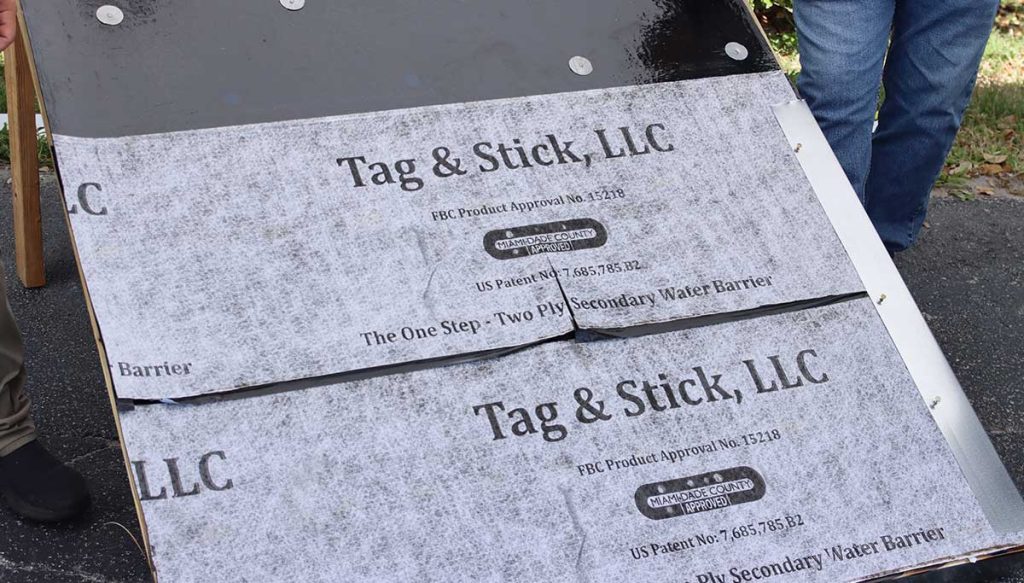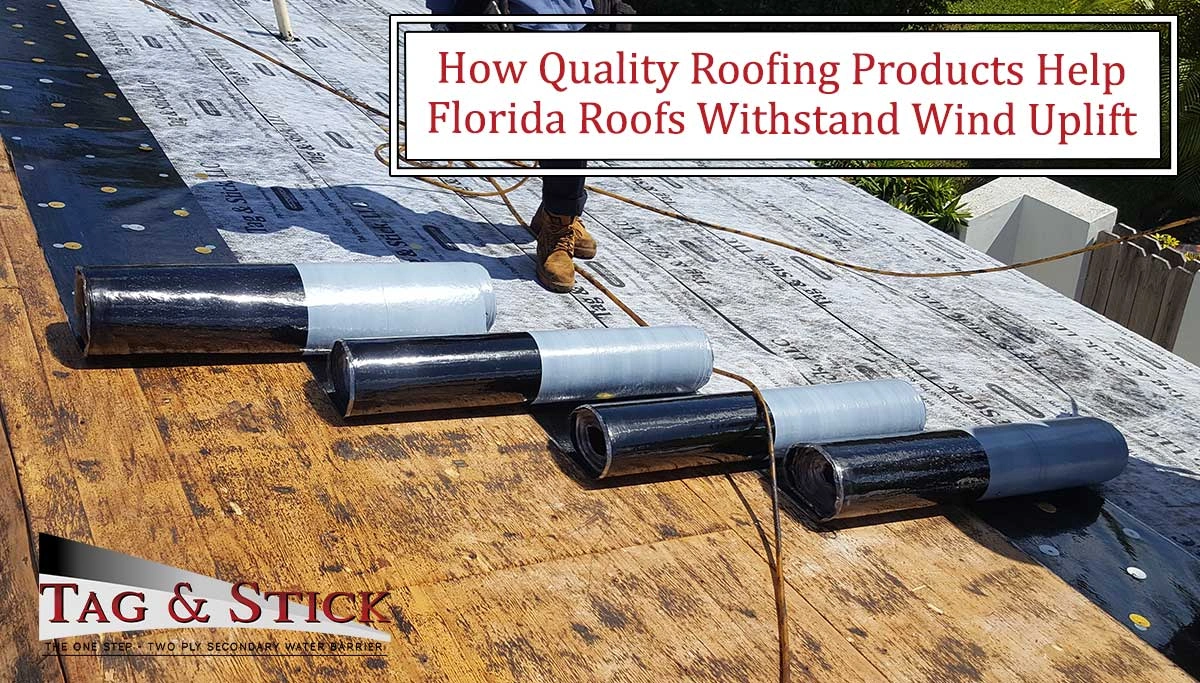How Quality Roofing Products Help Florida Roofs Withstand Wind Uplift
- Understanding Wind Uplift Pressures on South Florida Roofs
- What to Look for in High-Quality Roofing Products for Wind Resistance
- The Unsung Hero of Quality Roofing Products: Underlayment’s Role
- Fortify Your Roof with Tag & Stick’s Underlayment, Made to Withstand Wind Uplift
- Experience The Tag & Stick Difference
In South Florida, roofing systems face some of the toughest weather conditions in the country. Year-round gusting winds, tropical storms, and hurricanes put every roof to the test, especially when it comes to a force called wind uplift.
In Palm Beach, Miami-Dade, and Broward Counties, roofs aren’t just battling rain. They’re fighting intense pressure differences that can pull materials right off the structure. And if the wrong materials are used? One small failure can lead to major, costly damage.
That’s why quality roofing products matter more here than almost anywhere else. For homeowners, builders, and roofing pros, products like Tag & Stick’s self-adhered, 2-ply modified underlayment offer the strength needed to meet and exceed South Florida’s high material standards.
Discover how wind uplift works, what roofing codes require, and what you should look for in roofing materials built to last.
Understanding Wind Uplift Pressures on South Florida Roofs
Wind uplift occurs when wind flows over a roof, creating a pressure difference between the air above the roof and the air trapped inside the building. As the wind moves faster across the roof surface, it lowers the pressure above the roof while the higher pressure inside the building pushes upward. This pressure imbalance (and suction effect) can lift roofing materials away from the structure, causing them to loosen, peel, or completely detach, especially at the edges and seams.
In these conditions, it’s the roof’s edges, corners, and ridges that become the most vulnerable. And while South Florida’s High-Velocity Hurricane Zone (HVHZ) codes require rigorous testing of area roofing materials, subpar underlayment could risk major failures during these critical storms.
Meeting and Exceeding Florida Building Code Standards
With every new storm or hurricane that makes landfall, Florida building codes get more stringent. A section of these roofing codes outlines the Florida Code roofing standards that must be met. Most roofing professionals will already be familiar with these regulations.
Tests include:
- UL 1897: Tests the uplift resistance of roofing systems.
- ASTM D1970: Standards for self-adhering polymer-modified bituminous sheet materials.
- TAS 117: Miami-Dade’s testing for wind resistance and uplift.
While codes set the minimum requirements, many homeowners and roofing professionals choose products that exceed them, especially for peace of mind during hurricane season.
What to Look for in High-Quality Roofing Products for Wind Resistance

High-quality materials have several features that make them the premium option. These materials, designed for durability, improve the overall performance of the roof when used together. The result is a roofing system that stays in place when a powerful storm comes through.
Not all roofing materials are created equal. For a roof that stands strong through hurricane-force winds, look for these features:
- Strong Attachment Systems: High-quality adhesives and fasteners create a stronger bond, minimizing the risk of material detachment.
- Thicker, Flexible Materials: Premium shingles and membranes are designed to flex without cracking or tearing.
- Reinforced Edges: Since upwind pressure is greatest at roof edges, reinforced edges help prevent peeling and blow-offs.
The Unsung Hero of Quality Roofing Products: Underlayment’s Role

Roofing pros know that underlayment is both a backup moisture barrier and a bonding layer that locks roofing systems together. But without quality underlayment, those heavy wind gusts and hurricane blasts can shear away that bond, leaving only the deck and finish material to fight uplift forces. Loose-laid and low-quality underlayment materials will lack the strong adhesion needed to resist those HVHZ conditions.
When you’re sourcing underlayment, be sure to look for:
- Material Composition: Inorganic materials resist rot, mildew, and degradation from humidity and UV exposure, perfect for Florida’s climate.
- Adhesion Method: Self-adhered systems ensure fewer mechanical failures versus loose-laid or nailed-down sheets.
- Ply Structure: A true 2-ply application like Tag & Stick delivers superior strength without the need for layering multiple products.
- Testing and Compliance: Look for Miami-Dade NOA approvals, TAS 117 testing compliance, and adherence to ASTM D1970, all required benchmarks for top-tier performance.
Seamless Waterproofing
Water is one of the greatest enemies of roofing systems. Even the smallest roof leak can cause costly and significant damage over time. Leaking water compromises the integrity and strength of the roofing system. High-quality sealant systems and underlayment provide an extra layer of protection. There are several high-quality waterproofing options available.
- Bituminous membrane waterproofing
- Liquid waterproofing membrane
- PVC and TPO roofing membranes
- Rubberized asphalt
Fortify Your Roof with Tag & Stick’s Underlayment, Made to Withstand Wind Uplift

Tag & Stick’s self-adhered underlayment is engineered for South Florida’s toughest weather challenges.
Fortify your roof and your customers’ roofs to enjoy these additional benefits:
- Fastened Directly to the Deck: Unlike fully adhesive systems that rely solely on chemical bonds, Tag & Stick combines mechanical fastening with adhesion for ultimate uplift protection.
- One-Step, Two-Ply Application: This patented system applies in one step but functions like a traditional 2-ply assembly, increasing durability while reducing installer error.
- Inorganic Modified Composition: Highly resistant to moisture, mold, and thermal degradation, ensuring long-term performance even in brutal tropical climates.
- Code Compliance: Fully tested and approved to meet Miami-Dade and Florida Building Code HVHZ requirements, ensuring legal compliance and peace of mind.
For contractors and engineers, it means fewer headaches and stronger roofs. For homeowners, it means peace of mind no matter what the weather forecast says.
Experience The Tag & Stick Difference
Choosing quality roofing materials is crucial for protecting your South Florida home from the powerful forces of wind uplift. With more than 25 years of experience in South Florida’s roofing industry, no one better understands the unique roofing challenges contractors and homeowners face than Tag & Stick.
Chat with us directly today at 954-255-3107, or be sure to ask your roofing contractor about Tag & Stick. Let’s secure your roof against the unpredictable challenges of South Florida’s weather.
